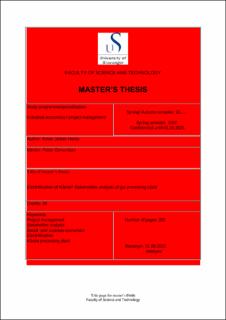| dc.description.abstract | The main objective of this thesis is to perform a stakeholder analysis of the key stakeholders in the Kårstø Partial Electrification (KPE) project. This will be done primarily through interviewing different types of stakeholders. The objective is to identify both the most important and potential problematic stakeholders in the project, and how it can affect the project’s outcome.
In this public version, most interviewed individuals and companies will be anonymized. Because whom these interviewees are has no actual relevance to the objective of this thesis. Anonymized companies will be marked as: Shipper_1, Shipper_2, Owner_1, Owner_2, Owner_3, Owner_4.
KPE project.
All proposed concepts from the DG2-Document had a high abatement cost and negative NPV. A negative NPV on electrification projects is to be expected. However, not to this extent. Consequently, all shippers opposed maturing to a concept phase.
Owner_1 and Shipper_1 is considered to be unpredictable in KPE. In that sense that they changed their mind regarding DG2 endorsement. This came as a big surprise for the project manager at Gassco. As Gassco felt that both Owner_1 and Shipper_1 was already on-board with the project. From the stakeholder mapping, Owner_1 and Shipper_1 is considered the greatest danger or opportunist for the project as-is.
As a result of this, the project restarted. However, DG1 is already passed, and a new DG2 proposal is coming autumn 2020.
Gassco wants, and the most likely step forward is to split investments and CO2 emission reductions for the KPE building blocks (reducing scope), and then present a stepwise implementation with decision gates. Aiming for abatement cost significantly below the level indicated in the current DG2 document, update estimates for optimized solution. Additionally, align the concept selection with the Gassco strategies, “Kårstø Future Strategy” (KFS) and “Future Gas Infrastructure” (FGI). Stakeholders overall seems more satisfied with this approach.
Generally.
Having talked to so many different types of stakeholders in the KPE project and about electrification in general, there is no doubt that there are many different views on the same issue. What is right and who is right? Well, the answer to that lies in what type of stakeholder you look at it from. If you are a shipper, well then you will have a business economic perspective that describes what is right and wrong. If you look at this from a political angle, then long-term, safe and environmental measures are the way to go. The truth may lie in the fact that "no one" is right and "no one" is wrong. What do I mean by that? Well, none of the stakeholders are ultimately completely "objective". Therefore, the answer to "what is right, and who is right?", will be that no one is right but no one is wrong either. The right thing to do is to accept a compromise, where all parties win something and lose something.
If Norway chooses to electrify as a climate measure and thinks that we should sweep outside our own door. Then Norway should also ensure that the country is self-sufficient in green power, so that it does not just move emissions. | en_US |

